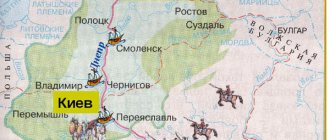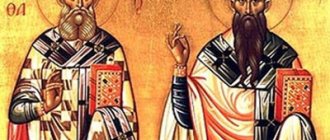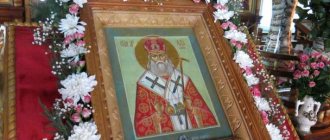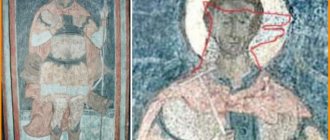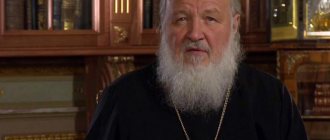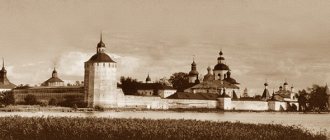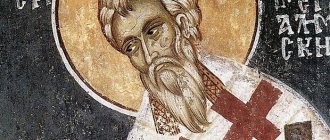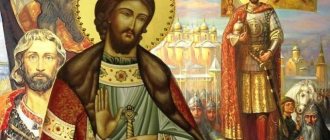Saint Cyril made a huge contribution to the development of Orthodox culture and the establishment of Christianity in the East. He was born into the family of a pious tradesman in the Greek city of Thessaloniki. He was the youngest of seven children; at baptism he was named Constantine; he received the name Cyril as an adult when he was tonsured as a monk. Since childhood, he was distinguished by his extraordinary mental abilities, for which he received the nickname Constantine the Philosopher.
Saint Cyril knew several languages and had knowledge in various fields of science of that time. But the main work of his life was the creation of the Slavic alphabet together with his brother Methodius. Before this, church services in Christian churches were conducted exclusively in ancient Greek and Latin. Before setting off for Macedonia in 863, the missionary brothers translated into Slavic the Lord’s Prayer from the Gospel of Matthew and the beginning of the Gospel of John, “In the beginning was the word...”.
From childhood, Saint Cyril was distinguished by his mental abilities and he studied together with the young Emperor Michael from the best teachers in Constantinople, including Photius, the future Patriarch of Constantinople. Upon completion of his studies, Saint Cyril accepted the rank of priest and was appointed head of the patriarchal library at the Church of Hagia Sophia, but a few years later he secretly left the capital and entered a monastery.
Church singing and the gospel word, thanks to Saints Cyril and Methodius, immediately sounded in an understandable language for every Slav
The spiritual feat of Saint Cyril, who was later canonized by the Orthodox Church as the holy Equal-to-the-Apostles “Slovenian teacher,” was of great importance for the formation of Slavic culture and writing. They gave people liturgical literature, the Holy Scriptures, a thorough translation of which is almost equivalent to the original. This was the first significant step in transferring to us, the Slavs, the entire amount of religious knowledge.
Righteous people named Kirill
The Orthodox Church, starting from the 4th century, canonized three dozen righteous people who bore this name and lived in the territory of Byzantium, the Western Roman Empire and Russia. One of the first in this personage is Cyril, the patriarch of the Egyptian city of Alexandria. He was glorified approximately in 451. Our most famous compatriots are the Monk Kirill of Radonezh, father of Sergius of Radonezh, who took monastic vows at the end of his life, and Kirill of Belozersky. Saint Cyril is the founder of the idea of enlightened monasticism and the comprehensive social service of the church.
Most often, boys at baptism are called by an ancient Christian name in honor of St. Cyril, the enlightener of the Slavs. Each saint must have his own iconographic image. The day of celebration of the heavenly patron is called Angel Day. And the heavenly patron himself is sometimes called a guardian angel. This term is conditional and not entirely correct. This is a completely different personal non-material entity. One of the manifestations of reverence for one’s heavenly patron is prayer through his iconographic image. An icon is a window to a higher world. It should promote a person’s internal concentration.
Biography of a saint
At birth, his parents gave the saint the name Constantine, but at the age of 18 he took monastic vows and changed his name.
As a child, the saint had very outstanding mental abilities; he made progress in many sciences. In his family circle he was even called a philosopher because he showed considerable interest in this science. Thanks to diligence and hard work, Konstantin successfully learned several languages and spoke them fluently, and had a large amount of knowledge in various areas of science at that time. For some time he even worked as a library worker, which operated at the Church of St. Sophia, but his calling was to serve people. He left the library for a monastery.
Another work of his life brought him fame and respect. With his older brother named Methodius, he came up with a new alphabet. Before this, all books, including church books, were written in Greek or Latin.
This caused some inconvenience for those people who did not speak these languages, so in the middle of the 9th century they developed a new writing system, which immediately gained popularity.
The brothers traveled around the world, teaching people new literacy. They continued to work on translating books from Greek and Latin into Slavic. They began work on translations with the most famous prayer - the Our Father.
Thanks to the titanic work of 2 brothers, the Slavs were able to fully understand church texts and hymns. Their translation of the holy books is still one of the best.
Beware, fetishism
In reality, a completely different picture emerges. On countless websites it is offered to purchase icons of saints and the Virgin Mary with detailed instructions on what exactly this or that image helps with. Moreover, you can meet supposedly competent believers who will advise who should pray and in what cases. This reduces the sublime meaning of the icon to an ordinary object of religious cult. The reasons are both the ignorance of the clergy and the banal desire for profit: clients pay for results. In some churches you can see a price tag similar to offers in the secular service sector, offering to serve a prayer service to a saint with almost a guaranteed result: about a lost item, about a successful search for a groom, so that your teeth don’t hurt, etc. This is also facilitated by the incompetence of believers, who They identify the holy image with a medicine in a pharmacy. I bought paracetamol, swallowed it - and it became easier. A very harmful misconception that can lead to negative consequences over time. After all, fire can not only warm you, but also severely burn you. You can have huge treasures with you all your life and not be able to use them correctly. A huge number of icons will not add grace, but, on the contrary, a careless and unworthy attitude towards them can be punished. The sacred image requires appropriate veneration. You should know that prayer in front of any icon can help alleviate any trouble.
How to pray in front of an icon
Before praying to Guardian Angel Kirill, you need to read his biography. This way a person will show respect for the saint. Anyone who is involved in education or science can pray to him - schoolchildren, students, teachers, professors. A saint can help in a situation where you need to speak in front of a large audience. Kirill previously had problems with public speaking, but was able to overcome his natural shyness.
Before the face of St. Cyril, people can ask for life wisdom and help in solving everyday problems. He can help a family in which disagreements have arisen between the spouses if he is asked to do so. The saint helps parents whose children have bad behavior - Kirill tries to guide them on the right path.
You can pray to him for good luck. If a person is going through a dark period in life, it seems that he is surrounded by problems - you can pray in front of the face of St. Cyril, and everything will work out.
The most powerful prayer to Saint Cyril will be on those days that are dedicated to him. During these periods, candles must be lit in front of the icon to honor his memory.
Often the saint is asked for help before important events in their studies: exams or difficult tests, but one should not assume that they can not prepare. St. Cyril can support and help a little, but subject to work from the student. If a person is lazy and does not prepare, the result will be predictable.
For the prayer before an exam to work properly, it must be learned by heart. This may seem a little difficult, since the language of prayers is unusual for modern people, but the result will be much greater than the effort that was spent on memorizing.
The icon can help in such situations:
- with panic attacks;
- in case of conflicts in the family and with friends;
- with the difficulties of choosing a life path.
How to properly venerate icons of saints
An icon should not be treated like a book or photograph stored on a shelf that can be used from time to time. If you have acquired a holy image, then even the smallest icon requires an appropriate reverent attitude. When venerating icons of saints, you first need to study the earthly life of the archetype. This brings the inner world of a praying person closer to the heavenly patron. On the other hand, a person located in another dimension is located in a somewhat special way towards the microcosm of earthly man, who shows reverent attention to her.
How to contact a saint
An icon depicting Cyril has great power, especially if it is consecrated in a church. If the face of a saint has not been consecrated, it may not help if you pray to him, but there is a belief that even if you pray to such an icon with sincere faith, an angel can hear and lend a helping hand. Saint Cyril was distinguished by his responsiveness and readiness to come to the aid of anyone who asked for it.
Many people do not take the icons they place in their apartments seriously. Every Christian must remember that a holy icon is a thing through which help from the Almighty can be realized, therefore it is worth treating it with respect.
People who bear the same name as the saint can receive the greatest protection from the icon - if you offer prayer words to your guardian angel, the effect will come faster. If a person turns to his saint, sincerely believing and thanking for his help, the patron will quickly convey the request to the Lord and contribute to its fulfillment.
Each saint has his own type of prayer. The prayer dedicated to Saint Cyril sounds like this:
The peculiarity of prayer for a saint is the time of its pronunciation: if you pray before sunrise, the saint can provide protection for his ward throughout the day. It will provide protection from such events:
- conflicts in the workplace;
- envy and gossip;
- unfriendly glances.
If you pray to your guardian angel in the evening before going to bed, you can get protection from bad dreams. Prayer at night can protect against damage and the evil eye. If you pray regularly, you can begin to see prophetic dreams.
Icon of the heavenly patron
You should definitely have in your house an icon of your heavenly intercessor, that is, the saint in whose honor the person is named. Don’t just store it somewhere in a sideboard behind glass, like some kind of souvenir. When looking at an icon, you should daily pray to the patron, at least briefly. It is also preferable to show attention to a righteous person close in occupation - the patron of work. For example, Saint Cyril, the enlightener of the Slavs, due to the labors he endured during his earthly life, is traditionally considered the patron saint of teachers and students. As well as an apologist for the ancient church, Patriarch of Alexandria Kirill earned the fame of a great preacher and writer. The icon of St. Cyril, the guardian angel and patron of Orthodox theologians, enjoys reverent veneration among theologians.
Guardian Angel Icon helps with good luck and more
"Save me, God!". Thank you for visiting our website, before you start studying the information, we ask you to subscribe to our VKontakte group Prayers for every day. Also visit our page on Odnoklassniki and subscribe to her Prayers for every day Odnoklassniki. "God bless you!".
It's no secret that everyone has their own guardian angel who always protects us. He worries not only about the body, but also about the soul. In difficult times for a person, it is necessary to remember that there are Higher powers that always guard well-being and pray to the Lord for the protection of the soul.
Icon of the Holy Guardian Angel
The image helps to overcome many difficulties. You can pray to him:
- in case you need support;
- to cope with fear;
- saved from misfortunes;
- about forgiveness of committed sins;
- about cleansing the soul, body and mind;
- to protect from troubles and adversity;
- kept from enemies;
- about guidance on the true path;
- about help at work and in personal life;
- for good luck;
- to atone for sins before God.
Icon of St. Cyril guardian angel
The name means “lord” in Greek, and “sun” in Hebrew. It is worth asking this face for help for those born from the twenty-second of June to the twenty-second of July. Kirill's name day is January thirty-first (according to the old calendar - January eighteenth).
There is a well-known fact from the life of Kirill. Once he was building the Belozersky monastery. Seeing this, the villagers thought that the man was very rich. One of the envious people gathered his servants to rob the monastery. Arriving at night, they saw warriors with drawn sabers guarding the monastery.
So the man waited until the morning, thinking that the soldiers would fall asleep, but they did not fall asleep and did not leave. It was decided to go the next day. But this time everything happened again. All the same warriors walked with sabers and no one slept. Then the envious man asked to find out what kind of warriors they were and when they retreated. The answer surprised him. There were no soldiers or even a pilgrim there. Everything became clear.
These were guardian angels who protected the monastery from robbery. The landowner repented and asked God for forgiveness for his action.
Prayer to the Holy Guardian Angel
Everyone needs prayer, because it is like a breath of clean air. There are prayers that you can read every day, but only once a year on your birthday. There are those that I read only in the morning, before going out or before going to bed. They are different so that everyone can find their own according to their needs and desires.
Every prayer has incredible power. The Guardian Angel hears all your requests and asks the Lord God for help for you. He not only does not leave us throughout life, but also does not leave us after death. In prayer you can repent of your sins, ask for protection, spend a day without evil, direct you on the path of salvation, and strengthen your faith. Ask for help from your soul so that it does not give in to temptation with these words:
“Holy Angel, standing before my accursed soul and my passionate life, do not leave me, a sinner, nor depart from me for my intemperance. Do not give room to the evil demon to possess me through the violence of this mortal body; strengthen my poor and thin hand and guide me on the path of salvation. To her, holy Angel of God, guardian and patron of my accursed soul and body, forgive me everything, I have offended you so greatly all the days of my life, and if I sinned this past night, cover me on this day, and save me from every opposite temptation May I not anger God in any sin, and pray to the Lord for me, that He may strengthen me in His passion, and show me worthy to be a servant of His goodness. Amen".
Icon of Saint Paul guardian angel
The image will protect you if those born from the twenty-fourth of August to the twenty-third of September pray to it. And also for those who were born from the twenty-fourth of October to the twenty-second of November. Before baptism, the holy apostle considered life to be a delusion, and that it brought only sins.
After he arrived in Damascus and was taught the faith, he was baptized. After baptism, he changed dramatically. He began to preach in different countries and found happiness thanks to his calling. He had to work and travel a lot to spread faith in the Lord.
Prayer for good luck to the guardian angel
There are times when problems overtake you, things are not going well at work and in life, lack of money sets in, everything starts to collapse and you don’t know how to deal with it. You want to ask for help, but you see the same exhausted people nearby. You do not meaningfully raise your head to heaven and tell everything to the Lord and ask him for help. You know that he always hears you and will always help.
You can pray anytime, anywhere. If your heart and soul needs to pray, then do it. Some believe that you need to pray only in a temple or church in front of an icon, this is not so. Don’t forget that you need to not only ask God, but also thank him for what you have and for his help. He helps you every day, every minute.
There are many prayers. But you can talk to the Lord in your own words. Your thoughts must be pure and sincere. Here is one of the prayers that will help you and give you good luck:
Prayer to the Guardian Angel for happiness and good luck
“Benefactor, holy angel, my guardian forever and ever, as long as I live. Your ward is calling to you, hear me and come down to me. As you have done me good many times, do me good again. I am pure before God, I have not done anything wrong before people. I lived by faith before, and I will continue to live by faith, and therefore the Lord has endowed me with His mercy, and by His will you protect me from all adversity. So let the will of the Lord come true and you, saint, fulfill it. I ask you for a happy life for yourself and your family, and this will be the highest reward from the Lord for me. Hear me, heavenly angel, and help me, fulfill the will of God. Amen".
Where to hang and help the guardian angel icon
There are no prohibitions on placing a face at home. Usually it is hung in the corner of the room. It will be best if the image faces east. If this is not possible, then it’s okay. It would be better if you made a special cabinet with shelves for icons with glass, which will protect them from dust and various damages.
This cabinet is called an icon case. There should be nothing nearby, because nothing should distract from prayer. Religious believers recommend hanging the faces of saints in every room. Don’t forget about the kitchen, because prayer while preparing food will sanctify the food.
Some people think it’s not right to hang the image in the bedroom. This opinion is erroneous, because marital intimacy is not a sin at all. It is advisable to pray before going out so that your guardian angel will protect you and help you in various matters. The Orthodox prayer to the guardian angel is pronounced precisely and clearly; thoughts, desires and requests should be formulated in advance.
Your guardian angel is with you from the moment of baptism. It not only prevents you from doing bad deeds and thoughts, but also records all your good deeds and deeds. He does this in order to present them before God's court. He is also the protector of soul and body. Those who are not baptized are under the control of demons. You can be baptized at any age, as long as it was not done in childhood.
God bless you!
In this video you will find out who the Guardian Angel is:
Pray in front of your icon, ask the Lord through it for healing, and it will definitely happen.
Those born from December 22 to January 20 will be protected
Prominent Personality of the Middle East
Saint Cyril was an extraordinary church figure, and on the other hand, a typical representative of his era. The exact date of his birth is unknown. He came from a noble Greek family. In Alexandria there was a kind of dynastic continuity in the hierarchy. The beginning of the tradition was laid by Patriarch Athanasius, who was succeeded by his nephew Peter. So Cyril took the department after the death of his uncle Theophilus. According to church historian Socrates Scholasticus, Cyril’s enthronement was accompanied by mass unrest in the city. Many parties fought for the throne, including heretics. It was possible to calm the citizens only thanks to the intervention of troops. Saint Cyril was a very active person and, having settled into the pulpit, began to claim the powers of a secular ruler. Then it was the call of the times. The first Christian communities were not only engaged in preaching doctrine among non-believers and spiritually nurturing their flocks, but also carried an enormous burden of social service to society.
In the 5th century, the Church struggled with numerous heretical teachings. By order of Cyril, all Novatian parishes in Alexandria were closed. Contemporaries testify that Saint Cyril not only waged an uncompromising fight against heresies and remnants of pagan ideology, but was also distinguished by aggressive anti-Semitism. The persecution of the Jews led to clashes with the Roman governor Orestes. The authority of the Egyptian See allowed the Patriarch to openly fight the heresy of Nestorius, who in 428 took the See of Constantinople. It was on the initiative of Cyril that the Third Ecumenical Council was convened, which approved the veneration of the Blessed Virgin Mary. He ruled the local Church of Alexandria for 32 years and died in 444. Cyril wrote many dogmatic treatises. The most outstanding exegetical works are interpretations of the books of the Old Testament prophets, the Gospel of Luke, John the Theologian and the epistles of the Apostle Paul.
Iconographic image of Cyril of Alexandria
The tradition of Christian painting has ancient roots of Syro-Palestinian origin. It is customary to depict saints on icons in accordance with the way of their earthly life. As a rule, a pictorial image is created at the time of the canonization ceremony. Sometimes more than a dozen years pass between the death of a righteous person and his canonization, and the image on the icon may not quite correspond to the portrait likeness. Unfortunately, due to the iconoclastic heresy that raged in the 8th century on the territory of Byzantium, many ancient icons were irretrievably lost. The most ancient images depicting the great patriarch of Alexandria, Saint Cyril, have not survived either. The modern icon depicts the saint in liturgical vestments corresponding to his episcopal service. An obligatory detail of the composition is the Gospel in the hands. In accordance with the iconographic tradition, emphasizing the reverent attitude towards the Holy Scriptures, the saint holds the book not with an open hand, but through the fabric of his vestment.
The meaning of the Guardian Angel icon
After all, for a true believer, the true goal is the salvation of his own soul, and the rest is secondary. And sometimes it's hard to get the mentorship and support you need in this world. That's when the Angel can help. It is also good to give an icon of the Guardian Angel to a child, who can begin his own spiritual path with this. Often it will be more convenient for a child to turn to an Angel, although it is necessary to correctly distinguish the difference between Heavenly forces and various fairy-tale creatures, for example, which a child can also learn about from books.
The image of the Guardian Angel can be placed in any part of the room, but in most cases they try to hang the icon in the corner of the room facing east. It will also be useful to have a glass shelf to protect icons from dust and pets. Before leaving home, it is advisable to pray to the Guardian Angel so that he will protect you throughout the day and help with any difficulties that arise. It is useful to formulate the content of the prayer in advance and, if possible, write it down on a clean sheet of white paper.
The priest can help you choose an icon of the Guardian Angel in accordance with the needs of a particular spiritual child. As a rule, the image is symbolic
After all, in this image there is not some historical figure, but an ethereal entity that is in the service of the Lord and also helps an individual person personally. Therefore, one should often recognize the image as a symbol, and establish a spiritual connection with the personal Angel. The icon of the Guardian Angel helps in many ways, and each believer over time cultivates his own spiritual connection, which helps to move along the spiritual path.
The Guardian Angel is always with you, he not only cares, but also keeps a record of your positive deeds and actions. This role was assigned to him in order to intercede with God during the supreme judgment. Therefore, it is useful for a believer to think about how the Guardian Angel will think about you when you do different things.
We recommend reading: Icons of the Archangels
Saints Athanasius and Cyril of Alexandria
The memory of Saint Cyril, Patriarch of Alexandria, is celebrated on June 22 according to the new style. However, the church established another veneration - January 31. On this day, the triumph of Cyril is celebrated together with another outstanding teacher of the church, his predecessor at the department, Athanasius of Alexandria. The joint celebration is determined in memory of recognition of their merits and exploits in defense of the dogmatic teaching of the Church. Saints Athanasius and Cyril are two great representatives of the Alexandrian theological school. Their works are important not only for intra-church use, but are also very relevant for sociologists, historians and psychologists.
Prayer to Saints Cyril and Methodius Equal to the Apostles
For the glorification of the enlightener of the Slovenian language, Saints Methodius and Cyril, Equal to the Apostles, having been enlightened by the light of your writings and teachings and being instructed in the faith of Christ, as children of our father, we now earnestly run and with contrition of heart we pray: even if we do not keep your covenants, for pleasing God we are careless and from the fraternal unanimity in the faith of those who have fallen away, both as in ancient times in your earthly life, do not turn away the sinners and unworthy people now, but, as you have great boldness towards the Lord, diligently pray to Him, that He may turn us to the path of salvation, that He may pacify the discord of those of the same faith, may he lead those who have fallen away to unanimity and unite us all with the spirit of love into the One Holy, Catholic and Apostolic Church! We know that the prayer of the righteous can do much through the mercy of the Lord. Do not forsake us, sad and unworthy, your children, for the sake of their sins your flock is divided by enmity and seduced by the temptations of the heterodox, they have diminished, while the sheep of words are torn apart, admired by destructive wolves. Grant us, through your prayers, the zeal of Orthodoxy, so that we may well preserve the traditions of our fathers, we will faithfully observe the canons of the Church, we will run away from all strange false teachings, and, thus succeeding in living a life pleasing to God, we will be worthy of heavenly life in Heaven, where together with you we will glorify the One God in the Trinity forever and ever. . Amen.
( 2 ratings, average: 5.00 out of 5)
Apostle of Eastern Europe
The greatest contribution to the culture of our fatherland was made by two brothers, Cyril and Methodius. Before taking monastic vows, Saint Cyril, Equal to the Apostles, bore the name Constantine. He and his brother Methodius came from a pious Slavic family. Their father was a military leader in the Greek city of Thessaloniki (modern Thessaloniki). Constantine received an excellent classical education at the emperor's court, for which he received the nickname of a philosopher. They became famous in connection with their unprecedented efforts to educate the East Slavic tribes. For the effective impact of Christian preaching, they compiled and put into circulation a new alphabet for Slavic tribes speaking related languages. After one of the creators, this monument was named Cyrillic. The brothers translated many liturgical books and the Gospel into Slavic. In order to be able to perform divine services in a dialect understandable to the Slavs, Constantine was ordained a bishop. Shortly before his death in 869, he accepted the monastic rank.
It should be noted that the clergy of the Russian, Serbian, Bulgarian and some other East Slavic churches have been using the original writing for more than a millennium. And if the modern languages of related peoples are already difficult to understand for each other, then the language of worship is absolutely identical. The feat of preaching activity of Constantine-Cyril is equated by the church consciousness with the feat of the apostles, therefore, during canonization, the saint was given the title “equal to the apostles”, and the days of celebration were not set on May 24 and February 27. In every Orthodox educational institution, in a place of honor there is an icon of St. Cyril, the guardian angel and patron of students and teachers.
The complete life of Equal-to-the-Apostles Constantine, in the monasticism of Cyril
Holy Equal-to-the-Apostles Constantine (Cyril) was born in the city of Thessaloniki (Thessaloniki) in 827. The parent of Saint Equal-to-the-Apostles Cyril, a noble and rich nobleman named Leo, and his mother Mary lived piously, fulfilling the commandments of God. Constantine - a royal name - was the seventh son. When his mother, upon birth, gave him to a nurse so that she could feed him, he did not want to feed on someone else's milk, but only on his mother's milk.
The city of Thessaloniki was home to a large Slavic population, whose language was familiar to Saint Cyril from childhood. There are suggestions that Saint Cyril was a Slav and is called a Greek in sources due to his membership in the Greek Church. When he was seven years old, Konstantin had a dream and told it to his father and mother in the following words: “The governor, the strategist of our city, gathered all the girls of the city and said to me: “Choose from among them whomever you want to help you and be your peer.” I looked around, looked at them all and noticed one, the most beautiful of all, with a luminous face, decorated with many golden monists and pearls and ornaments; her name was Sophia. I chose her." The parents realized that the Lord was giving the child the Virgin Sophia, i.e. Wisdom, they rejoiced in spirit and with diligence began to teach Constantine not only book reading, but also Godly good morals - spiritual wisdom. “Son,” they said to Constantine in the words of Solomon, “honor the Lord and be strong; keep the commandments and you will live; write the words of God on the tablet of your heart; Nartsy (call.—Ed.) Wisdom be your sister, And understanding (i.e., close, dear ones) create for yourself (Prov. 7: 1-4). Wisdom shines brighter than the sun, and if you have it as your assistant, it will save you from much evil.”
It is known what successes this youth showed in the sciences, especially in the study of the works of St. Gregory the Theologian. He studied Homer, geometry, dialectics and philosophy under the guidance of the logothete drome Theoctistus and the future Patriarch Photius. Even in his youth, Saint Constantine was called the Philosopher. In addition, he studied rhetoric, arithmetic, astronomy, musical art and other secular sciences, and also knew Latin, Syriac and other languages.
Although Saint Constantine was brought up at the royal court, together with the young Emperor Michael, and could have taken a high position, he remembered his Girlfriend, and therefore refused a noble and beautiful bride.
When Saint Constantine was elevated to the priesthood, he was simultaneously appointed librarian at the Church of Hagia Sophia. It was from this chosen one of Sophia that Russian Orthodoxy received its beginning.
The apostolic mission among the Slavs was for St. Cyril the pinnacle of feat, for which he was prepared by the Providence of God and St. Sophia all his life. After accepting the priesthood, Saint Cyril, striving for solitude, did not remain in Constantinople for long: he secretly left and hid in one of the monasteries on the coast of the Golden Horn. Only six months later the emperor managed to find him and persuade him to become a philosophy teacher at the main school in Constantinople. Saint Cyril returned to Constantinople. From the time he entered preaching and public church service, his strict zeal for the establishment of Orthodoxy became evident.
Saint Cyril’s first debate was with the leader of the heretical iconoclasts, Annius. The aged Annius was defeated and put to shame by the young philosopher Saint Cyril.
In 851, Saint Cyril, by order of the emperor, went to the Saracens to prove to them the truth of the Christian teaching about the Holy Trinity. This was the saint's first missionary journey, which he made at the age of 24.
Saint Cyril so skillfully defended the truth of the Orthodox faith and so exposed the falsity of the teachings of Muslims that the Saracen sages, not knowing what to answer him, tried to poison the saint. But the Lord kept His servant unharmed. Upon his return from the Saracens, Saint Cyril renounced the honorary position of teacher of philosophy and settled in a monastery on Olympus, where his elder brother Saint Methodius (815-885, Comm. April 6) labored. Saint Cyril spent several years in monastic deeds, prayer and reading the works of the holy fathers. On Olympus he began to study the Slavic language and became acquainted with Hebrew and Coptic writing.
In 858, ambassadors from the Khazars came to Constantinople with a request to send a learned man to them so that he would expose the lies of the Saracen and Jewish preachers who were trying to convert the Khazars to their faith. Emperor Michael III sent St. Cyril to the Khazars to preach the Gospel. His holy brother Methodius also went with him. Along the way, the holy brothers stopped for some time in the Crimea, in the Greek colony of Chersonesos. There Saint Cyril studied Jewish grammar. At the same time, Saint Cyril became acquainted with the Gospel and Psalter, written in Russian letters.
In Chersonesos, the holy brothers took part in the opening of the relics of the Hieromartyr Clement, Pope of Rome. Taking with them part of the holy relics, they continued their journey.
In the Khazar land, having won a dispute between Jews and Muslims, Saint Cyril converted many to Christianity. Refusing the rich gifts offered by the Khazar Khagan, Saints Cyril and Methodius asked in return to release all Greek captives. At their request, 200 people were released and returned to their homeland. In Constantinople, the holy brothers were greeted with great honors, like apostles. Saint Methodius retired to his monastery, and Saint Cyril settled at the Church of the Holy Apostles and began work on compiling the Slavic alphabet and translating the liturgical books into the Slavic language.
After some time, Saint Cyril and his brother went to preach Christianity in Bulgaria.
In 862 (or 863) ambassadors from the Moravian prince Rostislav came to Constantinople with a request to send Christian teachers. The choice of the emperor fell on Saint Cyril, who by the Providence of God had been prepared by that time for a great mission among the Slavic peoples. Despite his illness, Saint Cyril joyfully took up the task of fulfilling his obedience. Like any business, he began the feat of enlightening the Slavs with prayer, and then imposed a forty-day fast on himself. Soon, God, listening to the prayers of His servants, fulfilled what His faithful servant asked for: Saint Cyril compiled the alphabet for the Slavs (Glagolitic), and then, with the help of his brother and disciples, continued to translate the Greek Holy Books into the Slavic language. The first book translated by Saint Cyril was the Gospel of John. The Followed Psalter (which included the texts of troparia and kontakia for feasts and saints), various texts of the Holy Scriptures and liturgical books were also translated. This glorious feat of St. Cyril was the basis of the great work of introducing the Slavs to the Christian faith and culture. Since then, a new life has come for the Slavs, the possibility of original spiritual development has appeared under the beneficial effect of preaching and worship in their native Slavic language.
St. Cyril's struggle for the independence of the Slavic peoples was complicated by the fact that the work of enlightening the Slavs was begun in Moravia, a country under Roman influence. The German priests who headed the Christian churches in Moravia did their best to prevent the introduction of divine services in the Slavic language, believing that it should be performed only in three languages: Hebrew, Latin or Greek. Saints Cyril and Methodius, exposing their untruths with the words of Holy Scripture, tirelessly prepared the servants of the new Church. Under the leadership of the holy brothers, the Moravian prince Rostislav began the construction of temples and gathered many youths to teach the Slavic alphabet and reading translated books. In a short time, Saint Cyril and his disciples translated the church rites and introduced all Divine services according to the rules. This marked the beginning of the formation of independent Slavic Churches.
But the enemies of the cause of enlightenment of the Slavs continued to hinder them: they denounced Saints Cyril and Methodius to Pope Nicholas I, accusing them of heresy. The Pope summoned the holy brothers to Rome. Taking with them part of the relics of the holy martyr Clement, they set off on a new journey, which was very unfavorable for the health of Saint Cyril. Their path lay through Slavic lands. In Pannonia, at the request of Prince Kocel, they taught him and 50 young men the Slavic alphabet. When parting, the prince wanted to give gifts to the holy preachers. But Saints Cyril and Methodius did not want to take from Kocel, just like from Rostislav of Moravia, neither silver nor gold. They preached the Gospel word free of charge and only asked for freedom from both 900 Greek captives.
In Venice, the brothers made one more stop. There Saint Cyril again had heated debates with the “trilinguals.” He proved the right of every people to their own written language and referred to the Holy Scriptures and the experience of a number of peoples (Armenians, Persians, Georgians, Goths, Avars, Khazars, Arabs, Syrians, etc.) who had their own written language for a long time.
Before the arrival of the saints in Rome, Pope Nicholas I died. The new Pope Adrian II was friendly towards the holy brothers and greeted them solemnly, especially since they were carrying the relics of the holy martyr Clement. Pope Adrian II recognized the Slavic language in the Holy Scriptures and Liturgy, but was in no hurry to release the brothers for further preaching in the Slavic lands.
Exhausted by labor and long travel, Saint Cyril fell seriously ill. During his illness, the Lord revealed to him that death was approaching, and Saint Cyril accepted the schema. He devoted the remaining 50 days of his life to repentant prayer and conversations with his disciples and brother, instructing and teaching them, commanding them to return to the Slavic lands and complete the work they had begun. On February 14, 869, Saint Cyril gave up his soul to God, having lived only 42 years. His body was buried in the Church of St. Clement in Rome. The memory of Equal-to-the-Apostles Cyril is also celebrated on May 11, together with the memory of the holy brother Methodius.
In the iconographic tradition of the ancient Churches, Saint Cyril, Equal to the Apostles, is depicted in hierarchal robes, as for example in the 11th century fresco of the St. Sophia Cathedral in Kiev, or the 9th century fresco in the Church of St. Clement in Rome, which depicts the consecration of Saint Cyril as a bishop. These facts indicate that Saint Cyril was in the rank of bishop.
Images of the enlightener of the Slavs
Artistic images of the great teacher are widespread. In Orthodox churches in Eastern Europe you can find authentic frescoes depicting St. Cyril. The icon has several canonically approved versions. Constantine-Cyril is most often depicted in the vestments of a monk-schema. He took monastic vows of particular severity - the schema. When written together by two enlightenment brothers, Cyril is depicted only in monastic vestments. Since the saint was ordained, there are icons where he is depicted in the liturgical robes of a bishop. Invariably, in the hands of the saint there is either a scroll with the Slavic alphabet or an open book, most often the Gospel of John with the first lines of scripture. Kirill died when he was 42 years old. In modern tradition, he is depicted at approximately this age. On the few surviving ancient icons, the Slavic guardian angel Saint Cyril is represented as an old man with a rather long beard, forked at the end.
Name day day
The Primate of the Russian Church, His Holiness Patriarch of All Rus' Kirill, took this name during his monastic tonsure. A new name is given as a sign of renunciation of the past life and the beginning of a new, ascetic one, subordinate to completely different ideological principles. At the same time, the enlightener of the Slavs, Saint Cyril, became the heavenly patron of the future hierarch in monasticism. The Patriarch of Moscow sets an example of reverence for his heavenly patron. According to Christian canons, on the day of your Angel you should certainly partake of the Holy Mysteries of Christ. On May 24, the Orthodox world celebrates the holiday of Slavic literature and culture. On the day of his heavenly patron, His Holiness Patriarch Kirill obligatorily celebrates the Liturgy, if possible in a church dedicated to the saint. Also, every believer bearing the name Cyril, if he really wants to honor his heavenly patron, must take part in public worship on this day or at least go to the temple to light a candle.
Kirill's name day in 2021 according to the church calendar
- January 31 Cyril of Alexandria, Patriarch
- February 17 Kirill Novoezersky (Novgorod), Rev.
- February 27 Cyril (Constantine) Philosopher, Moravian, Equal-to-the-Apostles
- March 18 Kirill, martyr
- March 22 Cyril of Sebaste, martyr
- March 31 Kirill of Astrakhan, Venerable
- April 3 Cyril of Catania (Sicily), bishop
- April 11 Cyril of Iliopol, martyr, deacon
- May 11 Kirill of Turov, bishop
- May 17 Kirill Alfanov, Sokolnitsky, Novgorod, reverend
- May 23 Cyprian (Kirin, Cyril) of Bastia, Mesopolis, martyr
- May 24 Cyril (Constantine) Philosopher, Moravian, Equal-to-the-Apostles
- June 3 Kirill, bishop, Rostov
- June 22 Kirill Velsky
- June 30 Kirill Alfanov, Sokolnitsky, Novgorod, reverend
- July 22 Kirill, hieromartyr, bishop, Gortyn
- August 15 Cyril, martyr
- September 19 Cyril, hieromartyr, bishop, Gortyn
- October 11 Kirill of Radonezh, schemamonk
- October 11 Kirill, martyr
- October 23 Cyril of Zografsky, martyr
- November 20 Kirill Smirnov, hieromartyr, metropolitan, Kazan
- December 15 Cyril Phileot, Rev.
- December 21 Kirill of Chelmogorsk, Rev.
If the day and month of birth coincides with the date from the list, then this is the day of your patron. Don't be upset if you don't find your date of birth in the list; pay attention to the date that is closest to the next dates. This will be the date of the name day.
Spiritual conversation
Regardless of whether a person believes or not, the laws of the spiritual world apply. An analogy can be drawn with the laws of physics. Even if a person has never heard of Newton's law and the acceleration constant of gravity, universal gravity operates, and those who ignore it can suffer greatly. The world of metaphysics is still waiting for its researchers and discoverers, but for now we should listen to the thousand-year experience of the church. Appeal to the saints is usually called prayer. There are canonical prayers for liturgical use, which believers can also use at home. In prayer to St. Christians turn to Cyril of Alexandria as an assistant in the defense of all truth and piety. Preserving and spreading the faith is impossible without preaching. The success of a speaker is based on talent, comprehensive education and dedication. This is how Saint Cyril, a guardian angel, appears in the church consciousness for all those striving for enlightenment. The prayer to the righteous Equal-to-the-Apostles expresses requests for help in overcoming fraternal discord between peoples and preserving fatherly traditions and traditions.
